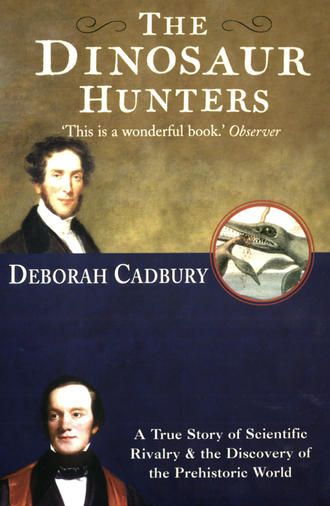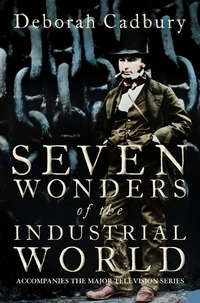
Полная версия
The Dinosaur Hunters: A True Story of Scientific Rivalry and the Discovery of the Prehistoric World
Although the archives suggest that Buckland had accumulated all this information from his meeting in 1818 with Georges Cuvier and subsequent correspondence, he was in no hurry to publish the findings. His reluctance to announce the find may simply have reflected a reasonable scientific caution. Unlike the ichthyosaurs that Mary Anning had found at Lyme, the Stonesfield animal was far from complete. But Buckland was also well aware that the Anglican authorities who had helped him obtain his stipend as professor from the Treasury were hoping that he would reconcile any geological discoveries with the Bible. A forty-foot reptile was hardly the ideal candidate. After all, there was no record of such a fantastic, almost mythical creature in Moses’ account of Creation.
Rather than devoting his time to combing the quarries for further evidence of his huge reptile, Buckland set his sights on another quest altogether: to discover proof of the biblical Flood. In 1819 he presented his inaugural address in geology at Oxford, ‘Vindiciae Geologicae, or The Connexion between Geology and Religion explained’. With great deference to the classical tradition, he explained why ‘no evil should be anticipated’ if geology was permitted to serve as ‘the handmaid of Religion’. He reassured the bishops and deans in the audience that there would be no opposition between the ‘Works’ and the ‘Word’ of God. There was no mention of the giant beast of Stonesfield; instead, Buckland expressed his conviction that the new science was bound to provide evidence of the recent origin of Man and the Great Flood.
By 1819, Buckland thought he had convincing evidence for the Deluge. Accompanied by his friend the geological enthusiast Count Breunner of Vienna, he studied the distribution of quartz pebbles and gravels across England. They traced these gravels ‘over the plains of Warwickshire, the Midlands, on some hills in Oxfordshire and in the valley of the Thames … to below London’. Later that autumn, Buckland wrote a paper for the Geological Society on ‘the evidences of the Recent Deluge’, in which he proposed that the fearsome torrents of ‘the first rush of the advancing deluge’ had swept these gravels across southern England. They had, he thought, retraced the actual path of the Flood.
The nearest source to which the Reverend Buckland and the Count could trace the pebbles was Lickey Hill in Worcestershire: ‘they present the same glassy brilliancy of fracture … the same small crystals of decomposing felspar throughout’. Consequently they believed the pebbles had originated from Worcestershire and had been ‘torn up by the waters of the last Deluge’. As the Flood subsided, ‘the weight and force of the immense volume of water … excavated the series of sweeping combs and valleys’, seen for example from Bath to Stow-on-the-Wold. Although Buckland could find no geological evidence to explain what prompted the Deluge and could not define the dimensions of the tidal wave, he was in no doubt that a giant surge or tidal wave had once occurred.
In pursuing evidence for a Flood, Buckland was hoping to resolve philosophical issues that lay at the heart of geology. This would not only add credibility to the new science but could also shed light on what happened to the ‘former worlds’ uncovered by geologists. There was, as yet, no framework within which creatures such as the Ichthyosaurus or the strange reptile from Stonesfield could be understood. Where did these beasts come from and, above all, what had happened to them? Why had God erased these creatures from the face of the earth? In England, where the Anglican faith dominated academic centres like Oxford, the best clue to extinction was the biblical Flood. But in France, naturalists were beginning to put forward new ideas.
Since the discovery that mammalian species such as the mammoth and the mastodon had disappeared from the earth’s surface, the puzzle of extinction had been keenly debated in Paris at the Muséum National d’Histoire Naturelle. Georges Cuvier and a senior colleague at the museum, the ‘Professor of Insects and Worms’ Jean-Baptiste Lamarck, had developed radically opposing theories. According to Lamarck, species were not necessarily extinct at all. They had developed by ‘transmutation’ into other forms of life.
Lamarck’s thinking stemmed from eighteenth-century beliefs that all living things were linked by imperceptible transitions; Nature was a continuous ‘Chain of Being’. The simplest organisms on the scale were those that maintained the minimum conditions for life, and Man, the supreme form, was at the top of the hierarchy. The great Chain of Being was an attempt to explain the incredible diversity of living forms in the absence of any chronology showing the order in which animals appeared on the earth. Lamarck believed that as organisms in this ‘scale of being’ strove for perfection they could transform themselves while adapting to their environment. Changing circumstances led to new responses from animals, which eventually became habitual. Organs could change permanently by frequent use or habits, allowing for the progression of animal forms into ever more complex types, without any special creation from God. This is what he meant by the ‘transmutation’ of species. In his Philosophie Zoologique published in 1809 he outlined a thesis in which humble creatures could ‘generate’ into higher forms of life.
Lamarck had little evidence to back up his ideas; the fossil record at the beginning of the nineteenth century was so incomplete that there was no proof of the progression of life over time. From his studies on fossil invertebrates, he could only show that the fossil molluscs such as ammonites and belemnites found in ancient Secondary rock were very different from living species. Neither did he propose a convincing mechanism to demonstrate how evolution might have occurred. Nonetheless, in his lectures he described the invertebrates as the most primitive forms of life and, he speculated, ‘perhaps the ones with which Nature began, while it formed all the others with the help of much time and of favourable circumstances’. His ideas on development implied that no species became extinct – they were merely transformed: ‘one may not assume,’ he wrote in 1802, ‘that any species has really been lost or rendered extinct’.
Jean-Baptiste Lamarck’s revolutionary thinking had worrying implications. Could intelligence and rational thought, the ‘God-given’ attributes which set Man apart from animals, have developed from more primitive forms of life? If organisms transformed themselves and higher forms could emerge from lower forms, then Man was not specially made by God. Buckland’s friend Conybeare was one of many to denounce Lamarck’s ‘ridiculous’ theory. It was ‘an idea so monstrous’, Conybeare told the Geological Society in 1821, ‘that nothing less than the credulity of a material philosophy could have been brought for a single moment to entertain it, nothing less than its bigotry to defend it’. The idea that Nature was autonomous and could randomly generate higher forms of existence, including Man, was greeted with intense hostility and roundly condemned.
In France, Lamarck had difficulty even in obtaining publishers for his ideas. Cuvier was so antagonistic to this ‘evolutionary’ thinking, it is thought that he advised the Emperor Napoleon not to accept a copy of Lamarck’s Philosophie Zoologique. It was a well-orchestrated public humiliation. In his lectures, Cuvier scoffed at the notion that organs could be formed by frequent use. He challenged Lamarck’s view that the entire animal kingdom was united in one genealogical tree. Cuvier believed that the differences between, for example, a humble mollusc and a complex vertebrate were so great that they could not possibly have arisen from a continuous chain.
Cuvier had developed a different theory to account for extinction, called the ‘Doctrine of Catastrophes’, according to which violent ‘revolutions’ had wiped away former worlds, destroying ancient forms of life. These ideas stemmed from a study he had undertaken with another colleague at the Muséum National d’Histoire Naturelle, the Professor of Mineralogy Alexandre Brongniart. Together they made a special study of the conditions under which fossils had become entombed in the Tertiary rocks of the Paris basin. For four years, almost every week, they took the carriage into the countryside around the River Seine.
Above the chalk of the Secondary strata they identified several major Tertiary formations. Each layer of rock had its own characteristic fossils, some containing marine invertebrates, others only freshwater creatures. These alternating layers of marine and freshwater formations led the two scientists to conclude that there had been repeated incursions of sea. Because there were ‘abrupt junctions’ between the marine and freshwater formations, they reasoned, the ocean had invaded suddenly, submerging the land for prolonged periods and destroying living species.
The ancient globe, Cuvier reasoned in his Essay on the Theory of the Earth, was punctuated by a series of ‘revolutions that were so stupendous that … the thread of Nature’s operations was broken by them and her progress altered’. He envisaged that prior to the creation of Man there were several different periods in the earth’s history, shown by the many different layers of rock in the earth’s crust that were filled with fossils. Each period ended in a dramatic geological ‘catastrophe’ in which species became extinct. ‘Life has often been disturbed on this earth by terrible events,’ wrote Cuvier. ‘Numberless living beings have been the victims of these catastrophes; their races have even become extinct.’
When Cuvier’s Essay was translated into English, the editor, Professor Robert Jameson of Edinburgh University, presented Cuvier’s theory as though the most recent ‘catastrophe’ was the biblical Flood. This was an obvious mistranslation of the Frenchman’s original ideas, which were based upon research within the Paris basin. Nevertheless, in England this was embraced as authoritative scientific backing for the Bible. William Buckland praised Cuvier’s ‘inestimable Essay’, and was eager to extend his notion of incursions of sea to ‘a recent Deluge acting universally over the surface of the whole globe’. He also hoped to show how this might correspond with the layers of rock that formed the earth’s crust.
By 1821, Buckland and his friends at the Geological Society had made considerable progress mapping the succession of strata in England. Following William Smith’s earlier studies, they identified several major formations in the Secondary series, complementing Cuvier’s studies of the Tertiary rock above. There was still little known about the oldest Primary and Transition layers. Nonetheless, Buckland and his colleagues had glimpsed as far back in time as the period now known as ‘Devonian’, the lowermost Secondary rocks. They called these ancient rocks the ‘Old Red Sandstone’. Above this, Buckland identified later rock formations: ‘Carboniferous Limestone’, succeeded by the ‘Coal Measures’, ‘New Red Sandstone’ (Triassic), ‘Jura limestone’ (Jurassic), and finally the most recent chalk and greensand (Cretaceous). These formations together made up the major periods of the Secondary series. Sadly for William Smith, when the gentlemen geologists of the Geological Society of London published their map, sales of his own map were cut to nothing. Smith became so poor that at one stage he was even reduced to spending time in a debtors’ prison.
Although little was known about the fossils in the different layers, this classification of the Secondary rocks proved to be remarkably accurate and still stands up to scrutiny today. Since, as James Hutton had argued, each layer of rock was formed imperceptibly, the result of gradual erosion and deposition over countless years, this classification lent powerful support to the idea of vast geological epochs before the creation of Man. Buckland was beginning to glimpse distinct periods in which centuries of prehistory buried in the earth’s crust could be defined.
Buckland was keen to integrate all these threads of evidence: the succession of strata, Cuvier’s ‘catastrophes’ and biblical records of a Flood. His opportunity came later in 1821, when quarrymen stumbled upon a cave at Kirkdale in Yorkshire containing ancient fossil bones. He hurried to the site, suspecting this would provide further insights. Surely the animals in the cave had been swept in by the terrifying, swirling Flood waters? What he found was stranger than anything he could have imagined.
Deep into the cave he went, on his hands and knees, the circle of light from a candle allowing him brief glimpses of what lay ahead, the voices of his companions echoing in the ancient silence. Undisturbed for centuries, the cave divided into passages that stretched back two hundred feet into the hillside. At first, all he could see was mud and silt. Gradually, it became clear that the scene was much more gruesome. Partially obscured by stalagmites and stalactites, ‘the bottom of the cave was strewed all over, from one end to the other, with hundreds of teeth and bones’. ‘Scarcely a single bone has escaped fracture,’ he said.
Drawings of the fossils were sent to Georges Cuvier, who confirmed Buckland’s suspicions that the bones were from many different animals jumbled together in disarray. These were creatures that never live together: tigers and deer, bears and horses, in addition to extinct species of elephant, rhinoceros, hippopotamus and hyenas. Furthermore, it was hard to envisage how large animals such as elephants could have passed through the two-foot entrance to the cave. Even more puzzling, Buckland observed from the splintered fragments and gnaw marks, all the bones appeared to have been half-eaten.
Buckland began to suspect that this was an ancient hyena den; the larger animals had been dragged into the cavern, a portion of the carcass at a time. He imported a hyena from the Cape and compared the gnaw marks on bones eaten by it with those from the caves. He soon wrote jubilantly to a friend, the Reverend Vernon Harcourt: ‘Billy [the hyena] has performed admirably on shins of beef, leaving precisely those parts which are left at Kirkdale and devouring what are there wanting … So wonderfully alike were these bones in their fracture … that it is impossible to say which bone had been cracked by Billy and which by the hyenas of Kirkdale!’
Buckland gathered more than three hundred hyena canine teeth from the cavern, and the bones of over seventy-five hyenas. Comparing these to skeletons of living species, Cuvier showed ‘that the fossil hyena was nearly one third larger than the largest of modern species. Its muzzle was shorter and stronger … and its bite more powerful.’ Since it was a species of hyena from genera that now only inhabit the tropics, Buckland reasoned that there had once been a tropical climate in Northern Europe. His interpretation of the cave as an ancient hyena den has proved correct, and when he presented his ideas to the Royal Society they were so well received that he was honoured with the Society’s prestigious Copley medal, never before given to a geologist.
Buckland told the Royal Society that the hyenas thrived in the ‘Ante-diluvian period, immediately preceding the Deluge’, and speculated that the extinct species in the cave were destroyed during the biblical Flood. These conclusions were based on the supposition that there were no human records of the species living in Europe since the Flood. As the bones were so well preserved in mud and silt he maintained the animals had been destroyed suddenly, and from the quantity of stalagmite in the cave above the mud he estimated that the inundation occurred six thousand years ago. In 1823, Buckland published a full-scale treatise, the ‘Reliquiae Diluvianae, or Relics of the Deluge’, in which he tried to fit this cave study and his earlier work on gravels with Cuvier’s most recent ‘catastrophe’.
Cuvier’s studies in the Paris basin had suggested that during each local catastrophe the land and the sea had changed places; this was reflected in alternating layers of marine and land strata. Buckland maintained that since the Yorkshire cave was inhabited by hyenas before the catastrophe that destroyed them, the area was land both before and after the Flood. The Flood, he reasoned, had been a transitory event during which the land remained in the same position. This lent weight to his view that any Flood should be viewed as a surge or tidal wave rather than a prolonged event. He also tried to show that the Flood had covered the whole globe. The fossils retrieved from the caves were identical to fossils found in loam and gravel deposits all over Europe, and so Buckland speculated that the same catastrophic event had destroyed the animals in the cave and swept the gravels to their positions. The gravel deposits were found in similar circumstances all over Europe, including hill sites, ‘to which no rivers could ever have drifted them’.
Although Reliquiae Diluvianae was immensely popular and sold out almost immediately, it unleashed a storm of comments from literalist theologians who believed in sticking to the letter of the Bible and disliked any conclusion that appeared to reduce the power of the Deluge. Rather than the caves being hyena dens, argued the Reverend George Young, a minister from Yorkshire, the awesome violence of the Flood had torn animals apart, limb from limb, forcing the confused debris of many of them into fissures in rocks and caves. The fractures and ‘bite-marks’ were not due to their having been eaten, but rather, testimony to the ‘wild confusion’ of the torrent in which the creatures were tossed and mangled. Others too, disputed that tropical animals had once lived in England. Tropical beasts were found in Yorkshire because the mighty currents had swept them thousands of miles. ‘Can we conclude with geologists that England must once have been inhabited by tropical animals merely because their remains are now found there, in a scattered and broken state?’ protested the theologian George Fairholme. ‘Had this not been the hypothesis of some of our ablest geologists it would have been termed the result of the most inconsiderate ignorance!’
As a backlash developed in response to Buckland’s interpretation of the Flood, other theological scholars challenged the idea that the Flood affected only the surface of the globe. In Moses’ account, ‘all the fountains of the deep’ were opened and the earth’s crust was totally destroyed by a mighty, raging torrent. According to Buckland, the Flood was a rather more modest affair, merely confined to shifting the superficial gravels. It wasn’t long before literalists objected to Buckland’s fundamental premise that geological epochs of immense duration had occurred before the Flood.
Layers of rock thousands of feet thick were demolished during the Deluge, according to the biblical scholar George Cumberland. ‘The fountains of waters contained in the great depths of the earth were broken up,’ he said. ‘Universal subsidence must have taken place. The operation must have been pretty rapid and immense layers of strata must have formed, filled up with the debris of the broken surface.’ Far from strata forming almost imperceptibly over countless years, there was a ‘sudden production of a thick sequence of rock!’ he claimed. ‘Such a world as ours might very well come forth in all its finished beauty instantaneously.’ The Reverend Young even produced an estimate of the speed of formation of the earth’s crust: ‘Provided there are currents to supply the materials, strata can form at a rate of nine hundred feet in a month!’ he declared.
George Fairholme captured the sense of outrage at the insolent new science that dared to challenge biblical records: ‘It is not unknown what ungodly avidity is exhibited by infidel philosophers … to distort every fact of science into a sophism against the Scriptures of eternal truth. Of these open scoffers … we have no dread; for the Bible has nothing to lose by being tried, like gold in the hottest crucible,’ he preached. ‘The gates of Hell itself cannot prevail against the word of God.’
William Buckland, with his blustering self-confidence and tremendous enthusiasm for his ‘noble subterranean science’, tried, as usual, to steer a path through these obstacles. But even his colleagues at the Geological Society questioned some of his evidence. How could he assume that the Flood was global, when gravels were found only in northern latitudes? The more the Reverend Buckland struggled to fit the findings of geology with the Bible, the more anomalies seemed to arise. Was Noah’s Flood transient or prolonged, global or local? Did the waters destroy only superficial layers or the entire earth’s crust? Were animals made extinct in one biblical Flood, or in a series of Cuvierian ‘catastrophes’? Or even, as Lamarck proposed, were species not truly extinct at all, merely transmuted into other creatures?
With some justification, one Scottish minister, John Flemming, summed up the confusion in a paper in the Edinburgh New Philosophical Journal: ‘The Geological Deluge, as interpreted by Baron Cuvier and Professor Buckland, [is] inconsistent with the testimony of Moses and the Phenomena of Nature.’ In Oxford, Buckland’s dilemmas were immortalised in a popular satire, Facetiae Diluvianae, in which Buckland met the great prophet Noah and each added to the bewilderment of the other.
Caught up in the storm at the birth of the new science, it is hardly surprising that the beleaguered Professor Buckland failed to announce the improbable discovery of a forty-foot reptile. However, Georges Cuvier in Paris was getting impatient since he wished to incorporate the information on the Stonesfield reptile in the updated volumes of his Recherches sur les Ossemens Fossiles. In September 1820, his assistant Joseph Pentland wrote to Buckland from the Muséum National in Paris: ‘Will you send your Stonesfield reptile, or will you publish it yourself?’ Deeply immersed in controversy, Buckland hesitated. A year later, the Reverend Conybeare also referred to the giant carnivorous lizard of Stonesfield in his paper on the Ichthyosaurus, adding ‘it is hoped [that Buckland] may soon communicate the results of his observations to the public’. But he did not. Soon, Pentland wrote once more, urging Buckland to announce the details of his research. Yet again, Buckland did nothing.
Thus the enormous bones continued to lie in the Ashmolean Museum, carefully prepared and neatly displayed behind the glass cages, an unexplained curiosity. They had become almost invisible by long acceptance, for over a century part of the paraphernalia of the museum alongside the stuffed animals and other objects. For the time being, in Oxford, the question mark they posed over the nature of giant reptilian beasts that had once lived on land was carefully and assiduously not seen.
4 The Subterranean Forest
To see a World in a Grain of Sand
And a Heaven in a Wild Flower,
Hold Infinity in the palm of your hand,
And Eternity in an hour.
William Blake, ‘Auguries of Innocence’
While William Buckland was preoccupied with grand theories and finding little time to investigate the giant reptile of Stonesfield, Gideon Mantell was rapidly becoming obsessed with the strange fossils emerging from the Weald in Sussex. As he began to prepare his first book, Fossils of the South Downs, during the late autumn of 1821, he wrote, with some excitement, that ‘the relics of a former creation’ that he had uncovered were as ‘extraordinary as any hitherto recorded’.
Everything about this secret, hidden world, buried beneath the Sussex landscape, seemed bizarre and unpredictable. One persistent puzzle was why the bones of large reptilian creatures should be found with fragments of tropical vegetation. After his first discovery in 1820 of what appeared to be an ancient ‘palm’ entombed in the quarries at Whiteman’s Green, Gideon Mantell tried to find out about tropical botany through his contact Charles Konig, at the British Museum.
Tropical plants had been known in Britain since Captain Cook, having discovered the east coast of Australia, Java, and Easter Island, returned from his voyage on the Endeavour in 1771. Accompanied by the botanist Joseph Banks, Cook had brought back hundreds of specimens that he had donated to the British Museum. Banks had later persuaded George III to turn Kew Gardens into a botanical research centre, displaying plants from all over the world. From these eighteenth-century explorations the English horticulturalists began to learn more about the hot, wet ecosystems, unmarked by seasons, within which these plants flourished.








